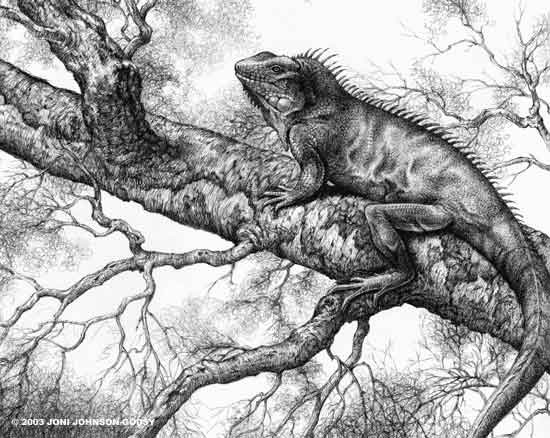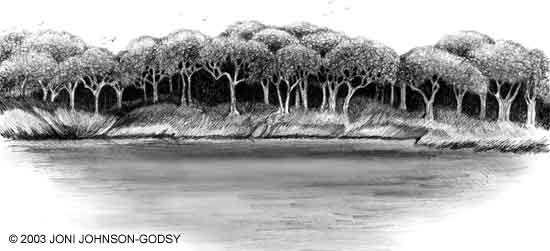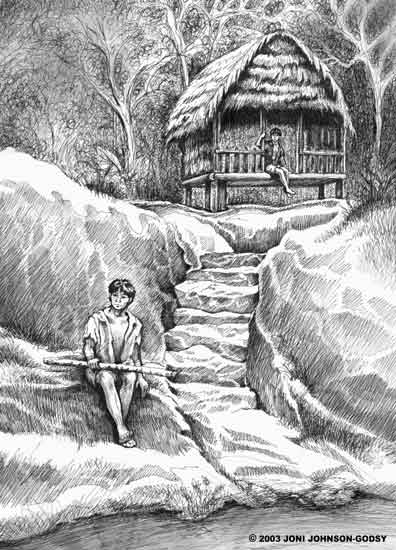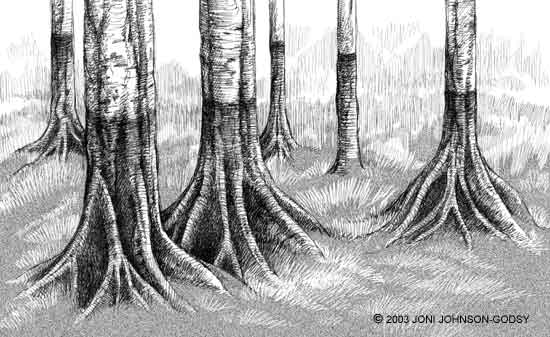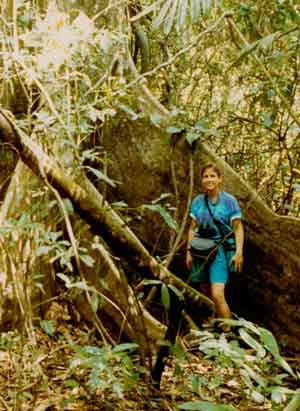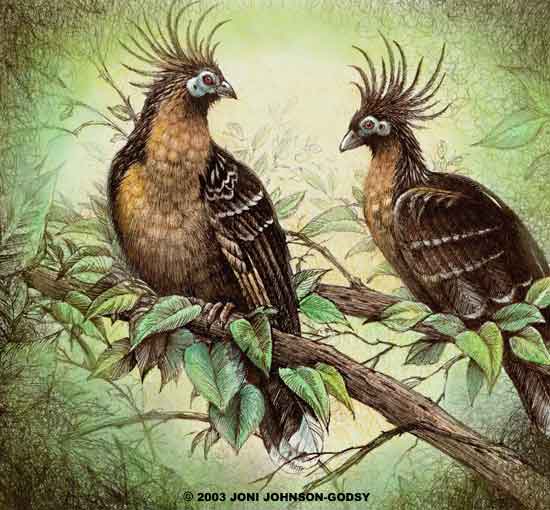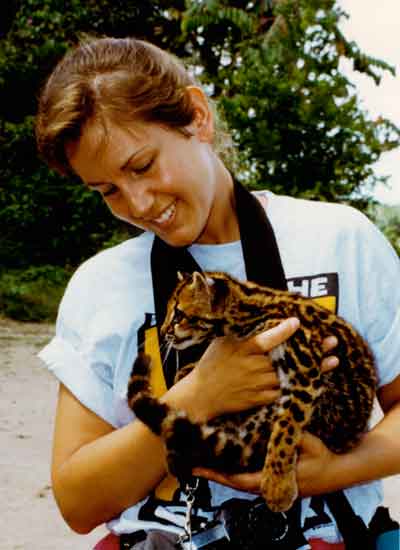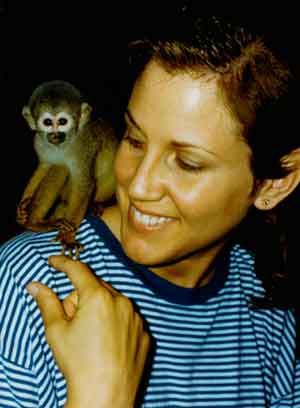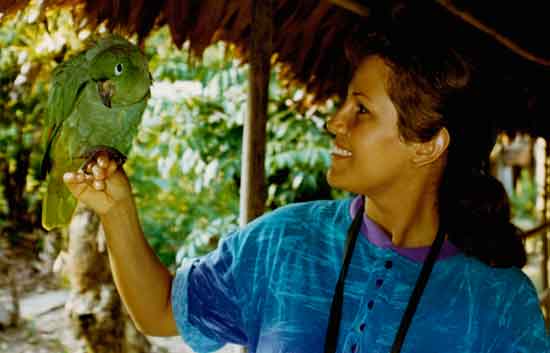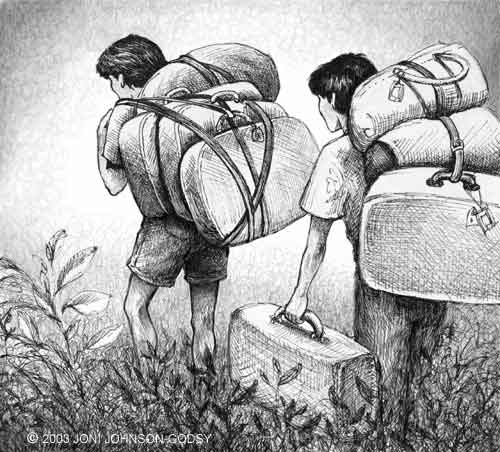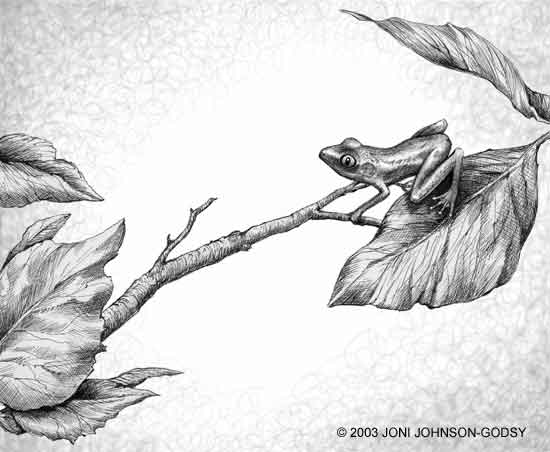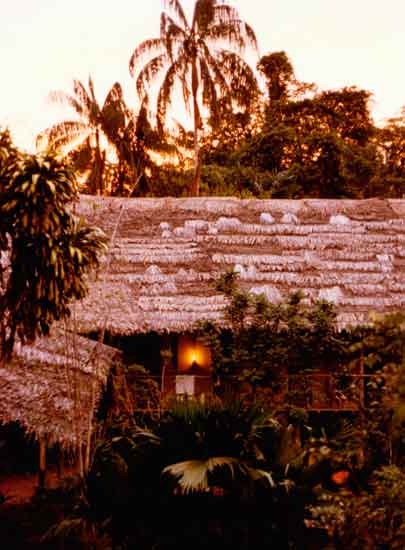The Amazon
|
||
Iguana, Amazon Basin, Peru The Amazon rainforest is among the world’s great natural wonders. The part of this vast wilderness I had the privilege to explore was in Peru on the Amazon River and its Napo tributary. I must admit that I was overwhelmed by the bio diversity there, which rivaled infinity. The tangled web of life in every square foot of space in the rainforest contained unimaginable drama. One could study this land for a lifetime and merely skim the surface of all there is to know. |
||
Toucan After a lengthy flight we arrived into Iquitos, Peru in the late evening. It was not what I had expected. This huge aircraft was the only one to travel to Iquitos from the US, making only one trip a week. The airport was nestled in a jungle of blackness with no runway lights that I could see. We touched down in complete darkness, which startled me. I didn't even know we were close to the ground. Extreme humidity pressed on us as we stepped out onto the long stairway down, humidity like I had never experienced before. There was a strange balmy sweet smell that permeated the air. The next thing I knew we were standing on the ground in eerie shadowy darkness awaiting our next instructions. As our plane turned, taxied back down the runway and lifted back into the sky, our only connection to familiar civilization lifted off with it. I noticed an uneasy feeling welling up in my stomach. Beautiful natives were dancing in the dim lighting of the landing strip. We danced with them to two Indian drums and a small flute endlessly playing no melody, while we waited in the customs line. Peru was in a political conflict with Columbia. The few lights that shown down from the tiny airport onto this paved area revealed the dark silhouettes of tiny Peruvian soldiers poised with machine guns, tucked back in the shadows cast by an assortment of small parked planes. They were there to protect their country and I could tell by the rigidity of their stance that they meant business. Although this seemed very spooky, we all were excited to be there and pretended not to notice. The customs process was long. The beautiful, gentle looking natives kept us busy with their music and their dance. Welcome to the Amazon. The next morning we had our first glimpse of the Amazon River. The day was sunny and balmy with absolutely no air moving at all. The massive river glittered in the equatorial sun taking no notice of us, or the poverty all around it. The water doesn't care. We traveled by boat eastbound on the mighty river for about fifty miles. Being more used to lakes than rivers I felt like we were on the world’s longest lake. The river was so wide and endless. |
||
Amazon River Shoreline We could view the jungle as we zipped along on the water. The shoreline was sparsely dotted with river natives perched on dried out mud beaches or in the doorways of their little thatched huts. They moved slowly because of the oppressive heat, but mostly they just sat and waited. I never really figured out what they were waiting for, maybe just tomorrow. One day blends into another for these people, separated only by the sun and the stars. There are no pressing deadlines, there is no rushing about and there is really little in their lives that MUST be done today. Their jobs are to survive the elements in a demanding landscape, and simply wait for tomorrow. |
||
Ribineros At length we arrived at Explorama, our first of three camps. The waterline of this great river is low during the months of July and August, and has a seasonal depth fluctuation of about forty feet. When the water recedes it reveals dark watermarks on every tree, permanently etched into the bark. Anyone coming here during the rainy season would have to travel this catacomb of jungle trails by boat. |
||
High Water Marks |
||
|
||
Three Toed Sloth
Hoatzin Birds Some wild animals seem to have an affinity for people. It can be fascinating to see a perfectly wild creature approach you for nothing more than to share your company. These animals had not been fed, and really seemed to be more curious about us than anything else. We were told to “handle them at our own risk”. It was for me, a risk worth taking. |
||
Joni with young Ocelot on the bank of Napo tributary, Peru
Baby Squirrel Monkey
Green Parrot After my little adventure I decided to relax with my sketchbook. This was the best way I found to “cool off” from the jungle heat. The view from the thatch covered platform where a dozen hammocks hung was dense jungle protruding right up to the platform’s edge. This area was an entire ecosystem within itself. There were countless species of tropical plants, some of which I recognized as familiar houseplants from home. Only these were giants, some having leaves that were longer than a person is tall. Bright noisy birds darted about everywhere and I had never seen so many hummingbirds. Lizards, insects and an occasional Tarantula would pop in and out of sight, going about life’s process, taking no notice of me. I liked it that way and felt privileged to be a spectator in a moment of their day. |
||
Joni relaxing with sketchbook at Explorama Camp After several days of exploring, it was time to gather up our gear and move on to the next camp. The ACCEER (Amazon Center for Environmental Education and Research) facility was almost an hour’s hike through the jungle from Napo camp, and we were pressing ourselves to get there before dark. I don’t know how many people in our group noticed the tiny Peruvian camp workers as they departed form Napo camp with our bags. I was embarrassed and somewhat ashamed as I saw those small men load up, each carrying literally hundreds of pounds of OUR luggage strapped to their backs for the long forty five minute walk through the jungle to ACCEER. They were gracious and silent while they walked each wearing a soft smile as we met them at the trail head. Some actually trembled slightly under the great weight, but never did a gentle smile waiver. These men do this continuously for American visitors without as much as a “thank you” that they can understand (most knew no English). They seemed appreciative of the job itself, which is a concept spoiled Americans would struggle to understand. |
||
Ribenero Camp Workers ACEER is a magical place. It is best known for the canopy walkways that cascade through the trees near the camp site. These long rope bridges sway and moan under your feet as you climb, draping themselves up through the rainforest canopy in stages, topping out at 110 feet in the air. Wooden platforms connect the different bridges and give you fabulous vantage points for viewing extraordinary wildlife. Each level of the canopy can be studied from this structure. I found ACEER to be endlessly fascinating and could have stayed at this facility for months. For me it was a real highlight of our trip. |
||
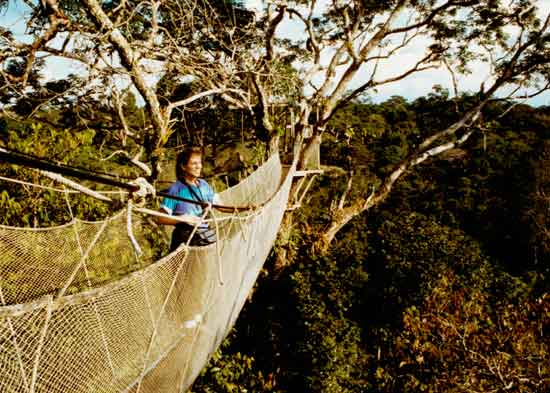
ACEER Canopy Walkway I can say without doubt that my adventure in the Amazon changed my life. It altered the way I view so many things and was a turning point for my life’s mission. It brought into sharp focus the pressing nature of environmental challenges we all face and made my paintings even more emotionally charged. There is a sense of urgency now to see things set right. We must protect ALL living creatures and insure them habitable environments in which they have the opportunity to thrive. |
||
Pigmy Tree Frog It is well known that the rainforest regions in the Amazon are disappearing at an alarming rate. This part of the world houses much of the vegetation which converts carbon dioxide back into the oxygen upon which we all depend. It is my hope for the future that the great species called Homo Sapien will gain enough wisdom to protect the very things that make this a habitable planet. |
||
Explorama sunset |
